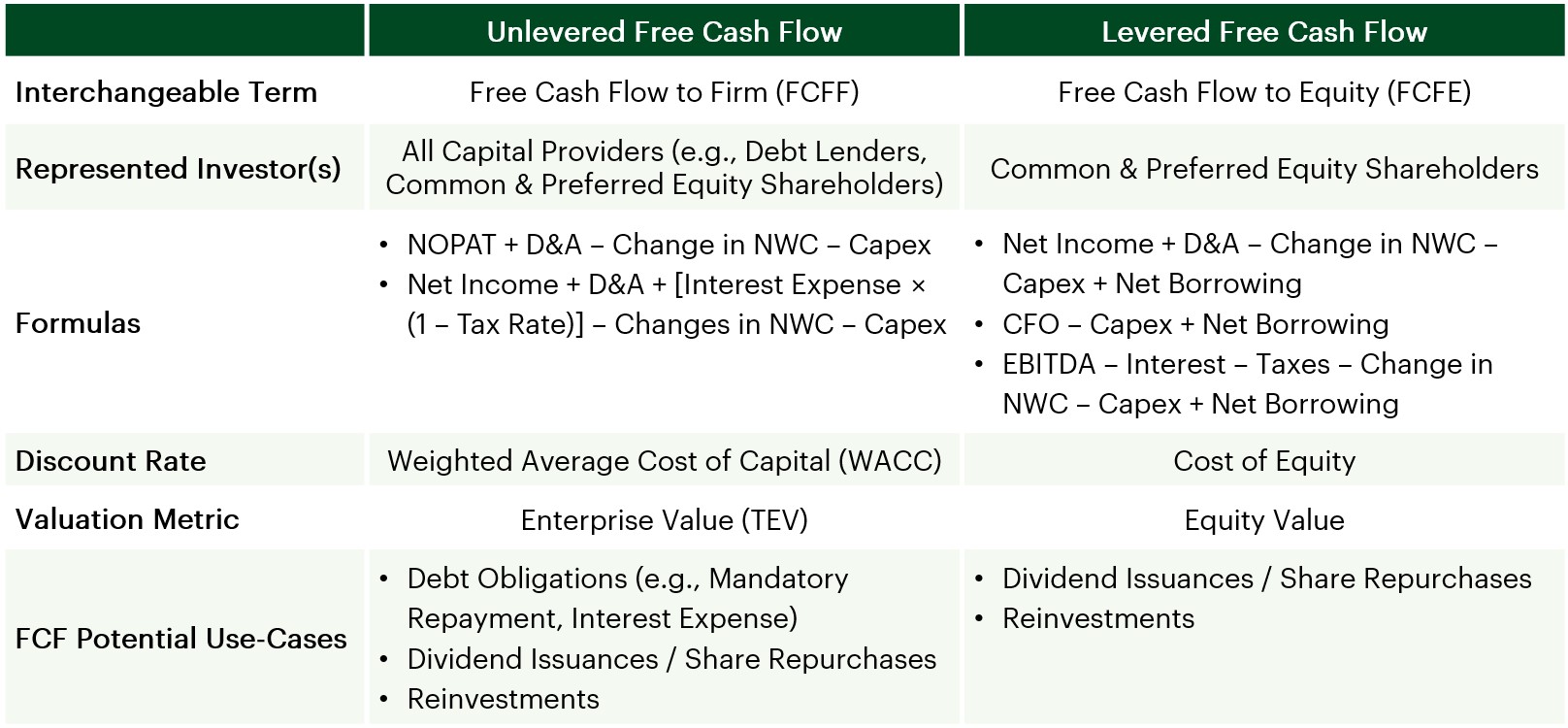Free Cash Flow Yield (FCF)
The Wharton Onlineand Wall Street Prep Private Equity Certificate Program
Level up your career with the world's most recognized private equity investing program. Enrollment is open for the May 1 - Jun 25 cohort.
Enroll TodayFree Cash Flow Yield Calculator – Excel Template
We’ll now move to a modeling exercise, which you can access by filling out the form below.
Step 1. Enterprise Value and Equity Value Calculation
To start, we are provided with information regarding the valuation of the company to calculate Total Enterprise Value (TEV) and equity value. Recall that TEV is the sum of the equity value and net debt.
To calculate TEV, we add equity value to net debt to arrive at TEV. The equity value of the company is $200mm while the net debt is $50mm, which are added together to arrive at a TEV of $250mm.
To calculate equity value, we start with TEV and then subtract the net debt to get to equity value. We subtract $50mm of net debt from the $250mm TEV to arrive at $200mm.
We are also given that the share price is $10.00. Therefore, we can calculate the share count by dividing the $200mm of equity value by the $10.00 share price, which comes out to 20mm shares.

Step 2. Unlevered Free Cash Flow Calculation (FCFF)
We now analyze the financials given the operating assumptions provided at the bottom.
Since revenue is $100mm and the EBITDA margin assumption is 40%, EBITDA comes out to $40mm. We then subtract the $10mm in depreciation and amortization (D&A) for an EBIT of $30mm.
This figure will be tax-effected by the 30% tax rate, which will be a $9mm reduction to get $21mm in net operating profit after taxes (NOPAT).
Because interest was not subtracted from EBIT before applying the tax, the impact of interest had already been removed from the equation.
With NOPAT calculated, we can begin working our way towards free cash flow to firm (FCFF), or unlevered FCF.
As D&A is a non-cash expense, we will add back the $10mm from earlier, which we originally subtracted because D&A is tax-deductible. But unlike interest, D&A is a core, operating line item that impacts all stakeholders.
Once we subtract the re-investment needs of the company, the $5mm in CapEx and $3mm in the change in net working capital (NWC), we arrive at the FCFF of $23mm.

Step 3. Levered Free Cash Flow Calculation (FCFE)
At this point, we must now calculate levered FCF from unlevered FCF. Intuitively, the expenses that impact non-equity holders must be accounted for in this section, so that we are left with only the residual cash flows for equity.
The process is fairly straightforward and we will deduct three debt-related items:
- Interest Expense: Periodic payments made to debt providers throughout the lending period, typically based on the outstanding debt principal (i.e., the cost of borrowing)
- “Tax Shield” of Interest: Interest is tax-deductible and reduces the taxable income (or earnings before taxes, EBT)
- Mandatory Debt Paydown: Required principal repayments back to the original provider per the lending agreement
So the first debt item is the $4mm in interest expense, which is a hard-coded assumption here.
Then, the adjusted interest amount could be calculated by multiplying the interest expense by (1 – tax rate).
By entering the $4mm interest assumption and 30% tax rate into the formula, we get $2.8mm as the tax-adjusted interest. Here, we have explicitly broken out the tax shield, which is the tax savings associated with interest.
Note that the interest tax shield is shown as a cash inflow since the tax savings are beneficial to all capital providers.
The final debt-related obligation is the mandatory repayment of $10mm. After summing up the FCFF with the three-line items mentioned above, the levered FCF comes out to $10mm.
Step 4. Free Cash Flow Yield Calculation Example
In our final section, we can calculate the unlevered and levered FCF yields.
For the unlevered FCF yield, we have an “IF” function saying that if the approach toggle selected is on “TEV”, then the FCFF of $23mm will be divided by the TEV of $250mm.

If the toggle is set on “Share Price” instead, then the $10.00 share price is multiplied by the 20mm in shares outstanding to get the equity value.
Recall, the valuation metric that corresponds to FCFF is the enterprise value, so we add the $50mm in net debt to arrive at the TEV in the denominator.
In either case, the unlevered FCF yield comes out to 9.2%. For the “Share Price” toggle approach, the reason we did not just link to the equity value and add net debt is to show an alternative approach where the formula is more dynamic, where we can adjust the calculation as under different assumptions for the share price.
The levered FCF yield formula also contains an “IF” function. In the first portion, if the approach toggle is set to “TEV”, then the FCFE of $10mm is divided by the $200mm in equity value.
Otherwise, if the toggle is on “Share Price”, the FCFE is divided by the current share price multiplied by the total shares outstanding. In this case, there is no need to add back net debt, since we want the denominator to be the equity value.

The completed model output is shown below. The levered FCF yield comes out to 5.1%, which is roughly 4.1% less than the unlevered FCF yield of 9.2% due to the debt obligations of the company.

Step 5. Unlevered vs. Levered FCF Yield Calculation Example
If all debt-related items were removed from our model, then the unlevered and levered FCF yields would both come out to 11.5%.
It should be intuitive that the unlevered and levered FCF yields are equivalent for all-equity companies that hold no debt on their balance sheet since the only difference between the two arises from the effects of leverage (debt).



No comments:
Post a Comment